We recently had the opportunity to reconnect with Melodie Mousset and dive back into EMPATHY CREATURES, a work reflecting on the importance of care in both personal and collective wellbeing, first presented at Venice Immersive 2025.
At GIFF 2025, we experienced a more advanced version of the piece, which will continue to grow with new content and meaning over time. We took the opportunity to explore with her the profoundly human and quietly revolutionary idea behind the work, and to reflect on the importance of something often underestimated: cuteness, and how it shapes human perception.
Inside a lush garden tucked within a busy corporate building, a small, delicate virtual bird flutters. Flaming red, teetering on the edge of burnout, it paces in circles, picks up cigarette butts, and bangs its head against concrete walls… Poor creature — so sensitive, so exposed. It lives, breathes, and feels without skin, mirroring the emotional exhaustion around it.
EMPATHY CREATURES is an emotionally intelligent immersive installation — somewhere between speculative fiction and poetic wildlife simulation. Unfolding in two parts, participants encounter an AI-powered being that senses them, talk to them, and gently invites them to slow down, listen and engage in mindful rituals of care. Like a collective Tamagotchi, the work explores emotional co-regulation, collective healing, and our shared responsibility in a fragile, interconnected world. Could a virtual creature help us reconnect with what makes us human?
EMPATHY CREATURES as a way to soothe anxiety and encourage care
MELODIE MOUSSET – I developed EMPATHY CREATURES during a residency at the Mobiliar Lab for Analytics in Zurich. The researchers there were analyzing stress in the workplace through AI models. They tracked how people typed on their keyboards and moved their computer mouse and these subtle behaviors became data points. From those patterns, they trained an algorithm to detect stress levels.
What they found was alarming: over one-third of the Swiss population was either already in chronic stress or very close to it. And chronic stress isn’t just a buzzword — it leads to burnout, it degenerates the body, and can contribute to serious conditions like cancer. It’s not a metaphor. It’s physiological, psychological, existential.
Of course, their research focused on office environments. But that kind of work is exactly what most people do today. So I thought: what if I made a piece that didn’t just talk about this, but tried to invert the process? Could we use the same kinds of technology to counteract what they reveal? That’s where the idea started.
So I was in this lab, doing the residency, and the idea kind of arrived all at once — like a complete package. I started talking with the scientists and casually said, “You should make something like this — maybe a creature, like a collective Tamagotchi”. I shared the whole concept and they loved it. They encouraged me to make it myself. At first, I hesitated. It felt like a great idea, but not something that belonged to me. It was cute and so different from what I usually create. I wasn’t sure I was the right person for it.
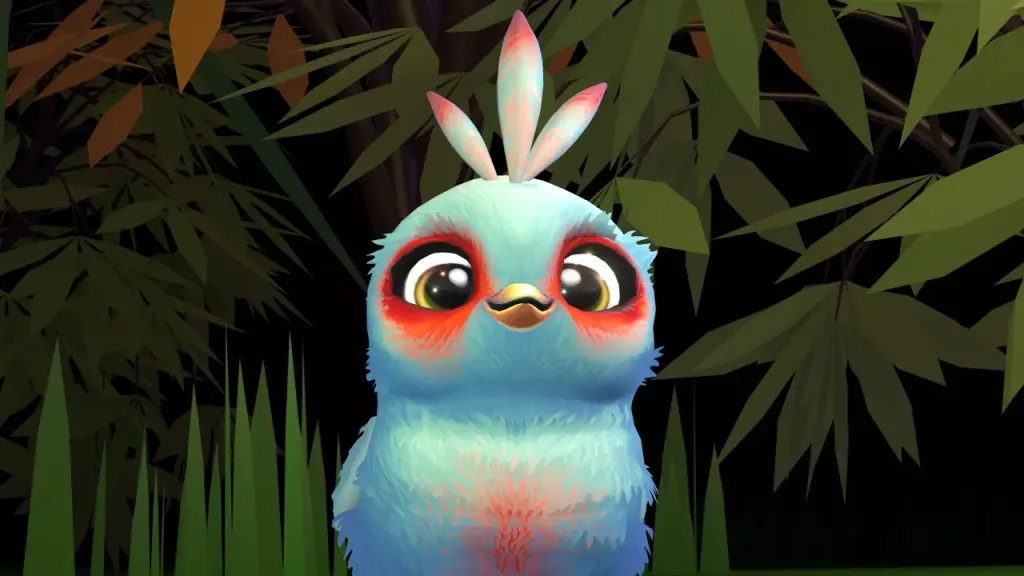
But then I realized: you have the ideas you’re ready for, and ideas come to you at a specific time in your life. And I was at a point where I was taking care of someone very vulnerable, my kid, and learning every day what care means and what it does to you. What it transforms in you.
Suddenly it made sense. The piece became autobiographical. I had to make it. It wasn’t for someone else. It came from where I was, right then. EMPATHY CREATURES began there.
VR between sympathetic magic and gentle resistance
M. M. – The cuteness in EMPATHY CREATURES is an aesthetic and it’s also a strategic choice. I actually realized this while presenting the work in Venice. I really leaned into cuteness. My reference for the bird was my son: the expressions, the big eyes. I anthropomorphized the bird’s features a bit, because my intention was rooted in research that shows how, when faced with something cute, we’re irresistibly drawn to care. It bypasses rational filters and goes straight to the deep brain.
So yes, I made it super cute to manipulate everyone (laughs) But it’s a smart, political strategy. In fact, the entire work revolves around cuteness and care.
And that’s because, while you’re caring for the bird, you’re actually caring for yourself. I designed all the interactions to connect you with your own body — to mechanically slow your heartbeat through breathing, or to make you blow a dandelion and feel your breath on your hand. That’s haptic feedback, a direct link to your own presence, to the world, to the theme. These types of interactions didn’t exist, I had to invent them. I actually spent a long time imagining ways I could “trick” people into engaging in wellbeing practices, but doing it by focusing on the bird instead of themselves. It’s, in a way, a form of sympathetic magic.
That’s exactly what I love about VR. It creates very tangible illusions because your body is involved. You move, you receive feedback, and in EMPATHY CREATURES, the bird reacts to what you do. That feedback loop makes the experience feel real. That’s where the emotional connection starts: in those micro-interactions.
One of the best examples of this is the moment when you blow a bubble on your finger. You literally blow air onto your VR hand. You feel that breath on your real skin. That’s biofeedback. Your body registers it, and suddenly there’s a giant, beautiful bubble forming from your VR fingertip. This simple act connects your breath, your body, and the virtual environment in a very direct way. It’s a strong moment of embodiment, and it gives you a very powerful sense of being present in the scene
Then, through cuteness, through “oh, I want to help this little bird”, you escape the building. You’re no longer just an employee. By letting this small, vulnerable creature guide you, by taking care of it and playing with it, you begin to find joy and reconnect with your inner-child curiosity and spontaneity. And it’s through those small gestures that you gradually find a new form of freedom. It’s the breach in the machine, the point of dissidence.
In this way, EMPATHY CREATURES becomes a metaphor for how care can heal society. It’s simple, it’s poetic, but it’s also political. A rebellion rooted in the poetry of care. That was my original idea: to use technology to disrupt the system of work, stress, and chronic pressure, and to create an experience of gentle resistance.
From Venice to GIFF: building trust, one breadcrumb at a time
M. M. – I think I realized, in Venice, that it was still too early in the development of the work. People didn’t really understand why the bird was getting stressed, because that part of the narrative wasn’t yet fully expressed. The concept was there, but not clearly communicated.
The core idea is that you’re surrounded by these towering buildings that block your entire perspective, your horizon: it’s almost like being inside a cage, a prison… more specifically, a workspace prison. As a participant, you embody one of the employees in that environment. It’s an oppressive place, essentially a machine designed to organize bodies and time.
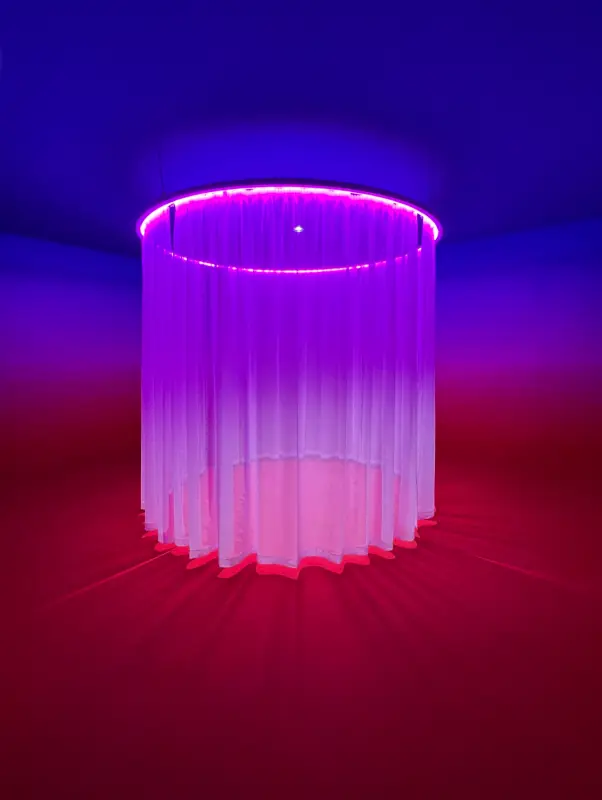
In the Venice version, most of that narrative wasn’t there, except perhaps in the architecture itself. So after Venice, I started focusing on building a new beginning, an intro without text, without voiceover. I just wanted everything to be conveyed visually, sonically, and through your interaction with the bird.
EMPATHY CREATURES now starts with you simply standing above the garden. The bird appears and begins eating a bit of your sandwich from the ground near your feet. Then you notice you’re holding the sandwich in your hand and you can offer it more. And that’s when it happens: a wave of stress emerges from the building.
The stress takes the form of a red, toxic substance, very visceral and invasive. It’s composed of machine sounds, typing, ventilation, paper shuffling — all these anxious audio cues from office life. The atmosphere becomes increasingly tense. The bird turns bright red, overwhelmed by it, and then suddenly becomes very frightened. It flies off and hides in its tree.
At that point, you’re teleported into the garden, and your task becomes to reconnect with it, to rebuild trust. Bit by bit, it starts to come out of hiding and trust you again.
I also broke down the menu structure from the earlier version where you would just pick an action from a list. Now everything unfolds as a continuum inside the garden. Once the bird leaves his tree, you can feed it a little, and it gradually trusts you more. That opens the door to more experiences. Its happiness and emotional state evolve throughout the entire piece.
This new version gives you much more time to interact meaningfully with the bird. You feel like your presence actually matters, like you’re making a real impact. It’s no longer a collection of mini-games. You move through the garden, and each path leads to a different experience. The bird guides you from one to the next. The flow is so much better now.


A collective Tamagochi
M. M. – I like to call this experience a collective Tamagotchi. The bird is driven by an AI — both inside the VR headset and on the PC — but what wasn’t obvious to everyone is how the project developed into two parallel parts.
On one side, there’s the VR experience: you interact with the bird directly, in an intimate and personal way. On the other side, there’s what happens on the large screen outside of the experience. That part shows the bird in its environment, outside of user interaction. It’s still powered by AI, but instead of reacting to people, the bird responds to its surroundings.
It has basic needs like waking up, eating, washing, flying, and looking for food, and it follows a kind of daily routine, entirely on its own terms. It’s almost like a virtual nature documentary, with a real-time camera following the bird through its world.
What’s interesting is that even though nothing actively “bad” happens in that environment, the bird still reacts to the invisible pressure of human stress and toxicity. It senses it and over time, it leads to a state of burnout.
But this is where the idea of collectivity comes in. When people enter the VR experience and engage with the bird in a caring way — and, in the process, feel better themselves — that care affects the bird’s wellbeing in the parallel world. Its state improves. Its environment changes.
This connection wasn’t fully implemented in Venice, but it’s a key part of how the work will evolve. The bird’s wellbeing — and even the health of the garden — will improve as more people participate and care. The more people engage, the stronger the entire system becomes. So it won’t just be about individual interaction anymore: it will become something persistent, shared, and ongoing. It will need everyone’s help.
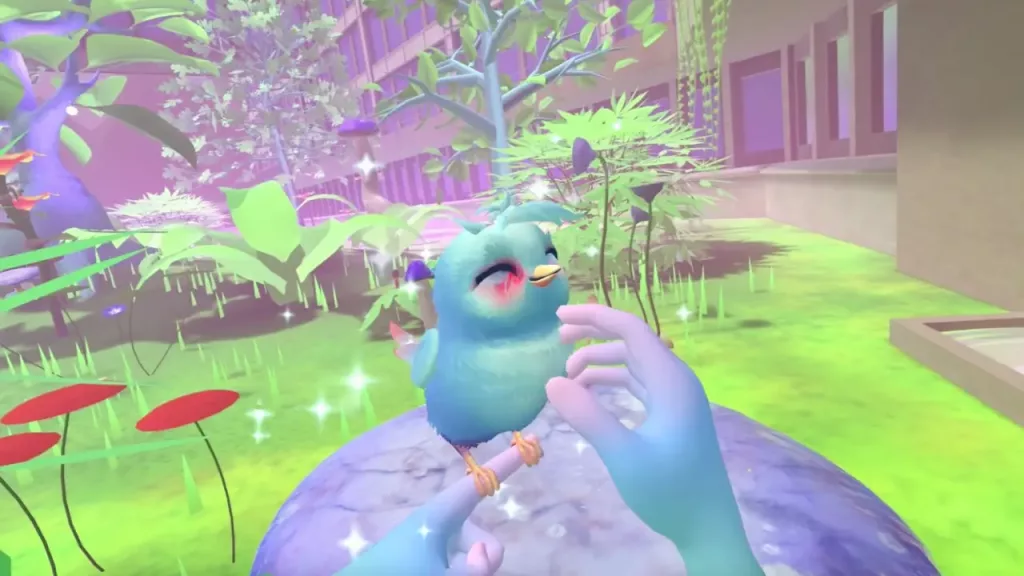
Many of these developments are planned for the next production phase, which I’m currently fundraising for. The work is still very much in progress.
In the next iteration, this shared impact will become even more visible. For example, the bird sometimes encounters cigarette butts or coffee cups scattered in the garden that upset it. In future versions, users will be able to clean the space, and those gestures will leave a lasting trace. Every action will contribute to the environment. Everything will connect back to this shared environment.
So the bird isn’t just yours. It belongs to the community. And the garden reflects what the community does… or doesn’t do.
A.I. mechanics in the interaction with the bird
M. M. – The AI part of EMPATHY CREATURES is powered by a French company called Virtual Beings. They developed a behavioral engine that animates emotions and movements in real time — especially for birds, which they’ve been specializing in for many years.
So this isn’t traditional animation, where you have to build the entire story in advance and the character follows a fixed path. Even in more elaborate animated setups, you might be able to pre-define a few branching choices. But here, it’s completely different. The bird in EMPATHY CREATURES is a sensing character, meaning it responds in real time to the user and the environment. And it’s unpredictable. You can’t fully anticipate what it’s going to do.
For example, if you caress it, maybe it enjoys it. But if the caress is too strong or too persistent, it might start looking at you differently. It might move away. Its vocalizations also happen in real time: the chirps are synthesized on the spot, adapting to its emotional state and the context. So everything — its mood, its decisions, its reactions — is dynamically generated.
When I had to reshuffle the experience for the GIFF, the AI system gave me real flexibility. Instead of going back into developing new animation, to fit the new structure, I could simply tell the system: “now the bird should come meet the user at the beginning.” From that point on, it decides where to perch, whether to look at you, how much bread to eat. It has its own sense of presence.
What I love is that it feels like the bird and I are co-directing the experience. I create the structure and the environment — but the bird has real agency. I can’t fully control it. That means every user goes through a slightly different experience. The path is the same, but the timing, reactions, and emotional texture shift with each encounter.
For instance, a friend of mine once accidentally fell on the bird when the bird was already starting to relax and reconnect. It turned bright red in panic and flew off again. My friend had to rebuild its trust from scratch. That wasn’t scripted. But it can happen, because the technology gives the bird its own sense of needs and responses.
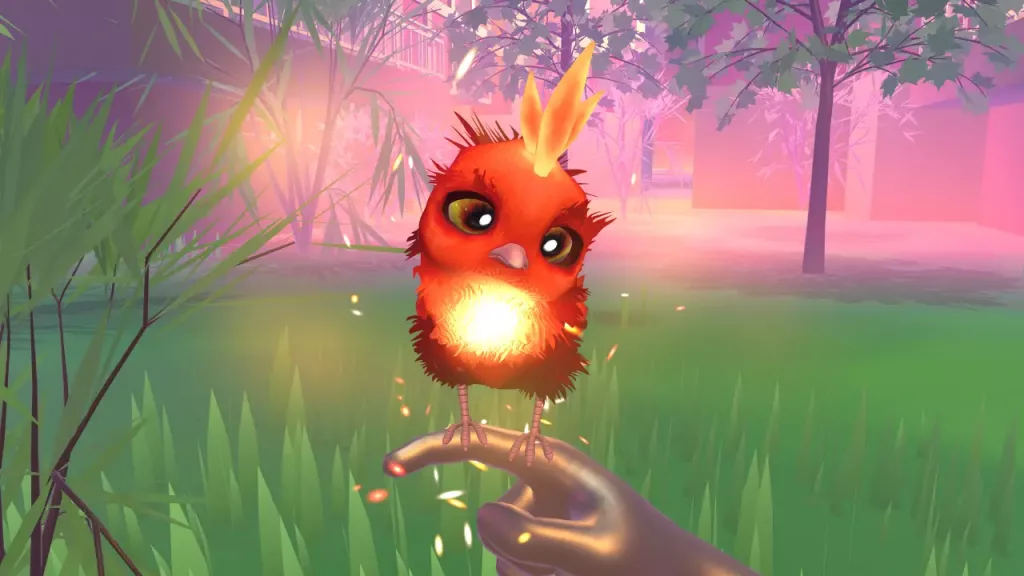
I’m not an expert in how the engine works since it’s quite a complex one, but I know that everything in the bird moves: the eyes, the tail, the wings. Thousands of micro-animations are layered and triggered in real time. Its expressions and gestures are always unique, moment-to-moment.
This is what makes the bird feel so alive compared to standard VR characters. It reacts to you. It listens to your voice. If you speak, it hears, analyzes, and responds — sometimes by mirroring your tone in bird language, sometimes by shifting it slightly. That vocal mirroring invites you to synchronize with it emotionally.
It’s a very powerful kind of technology, and it creates a very real kind of connection.
A gender gap in the emotional response to EMPATHY CREATURES
M. M. – I actually noticed something during the presentation in Venice, something that surprised me. Generally speaking, men didn’t seem to like the experience. The difference in engagement between men and women was very clear, and honestly, it gave me a lot to think about.
There was a kind of resistance, even some arrogance in the way many men approached the work and the bird. They didn’t want to interact with the bird, didn’t allow themselves to engage emotionally. It was strange and quite striking compared to how women reacted.
Other people were more open. They allowed themselves to be affected, to be guided by this small, vulnerable creature. They didn’t try to control the experience, they let it happen. In contrast, many of the men I observed seemed focused only on completing the task, making sure they reached the end correctly. That difference stayed with me and now I’d really like to do proper research on this. Because what I saw in Venice was too obvious to ignore. And in a way, I felt that maybe the ones who needed this kind of experience the most were the very ones who rejected it.
I’m not sure if it’s about the cuteness, or the fact that the bird is small and needs care — something that might feel emotionally challenging or unfamiliar. But at its core, the piece is about emotional connection. And we know that many men struggle with emotional openness — something society often teaches them to suppress.
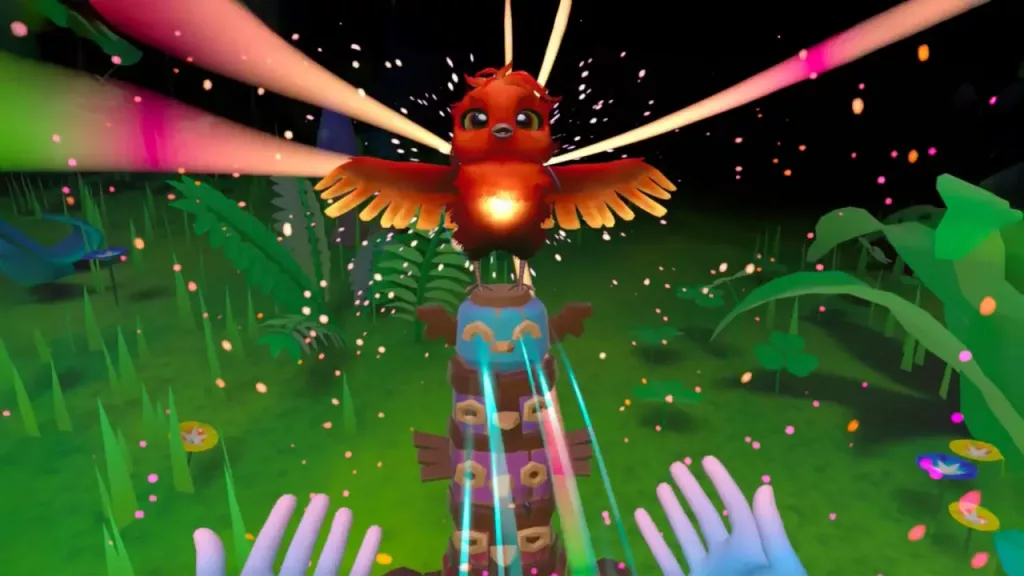
That’s why I want to look deeper into this. Because cuteness works on a neurological level. It speaks directly to the part of the brain that triggers care and I don’t believe this is something only women respond to. I think it’s universal. But I want to test that properly. I want to take my observations and hypotheses to researchers, to people who study this, and see if my work can help us understand us all more.
If I could find a way to make the experience resonate more with men, to help them open up even a little, I’d feel like I’ve achieved something important. It would feel like winning a small but meaningful battle.
VR as a creative sandbox
M. M. – People sometimes ask me if it feels strange — as an artist — to create an experience that, in the end, doesn’t really belong to me anymore. Something that others take over, shape, and live through in ways I can’t predict. But this is actually what I love about art, and about VR in particular: that, as an author, I can let go and let someone else “own” the story. Let the experience take flight on its own. And with EMPATHY CREATURES, it becomes even more obvious: I have no idea what your experience will be like, or what someone else’s will be. Every person who enters EMPATHY CREATURES might live something completely different. I could spend hours just watching people go through it, discovering how they interact, what unexpected moments arise. I’m sure I’d witness things I didn’t even know were possible in the piece. And I think that’s really exciting.
This has always been my approach to VR, even before I started using AI. All my works are structured as creative sandboxes — open systems where people can explore, experiment, and create their own meaning. The more you give, the more the experience gives back. That’s the part I can’t control, and that’s what I love about it.
My first VR piece already worked like this. It’s become my signature over time. It’s the reason I work in VR, because I don’t like to operate any other way.
I once tried to make a narrative film — a very personal story about a journey I had taken — and I just couldn’t do it. The editing process, having to choose between thousands of possible versions of the same footage, was a nightmare. What to include, what to cut, what to show first, what text to overlay: I found it unbearable. All those decisions, all those forks in the road, made me freeze.
That’s what I love about VR: I don’t have to choose. You choose. I set up the materials, the context, but then it’s your story. You go in, and you make it your own.
Because honestly, I hate choosing. I really do. For me, it’s a nightmare! A total nightmare. (laughs)

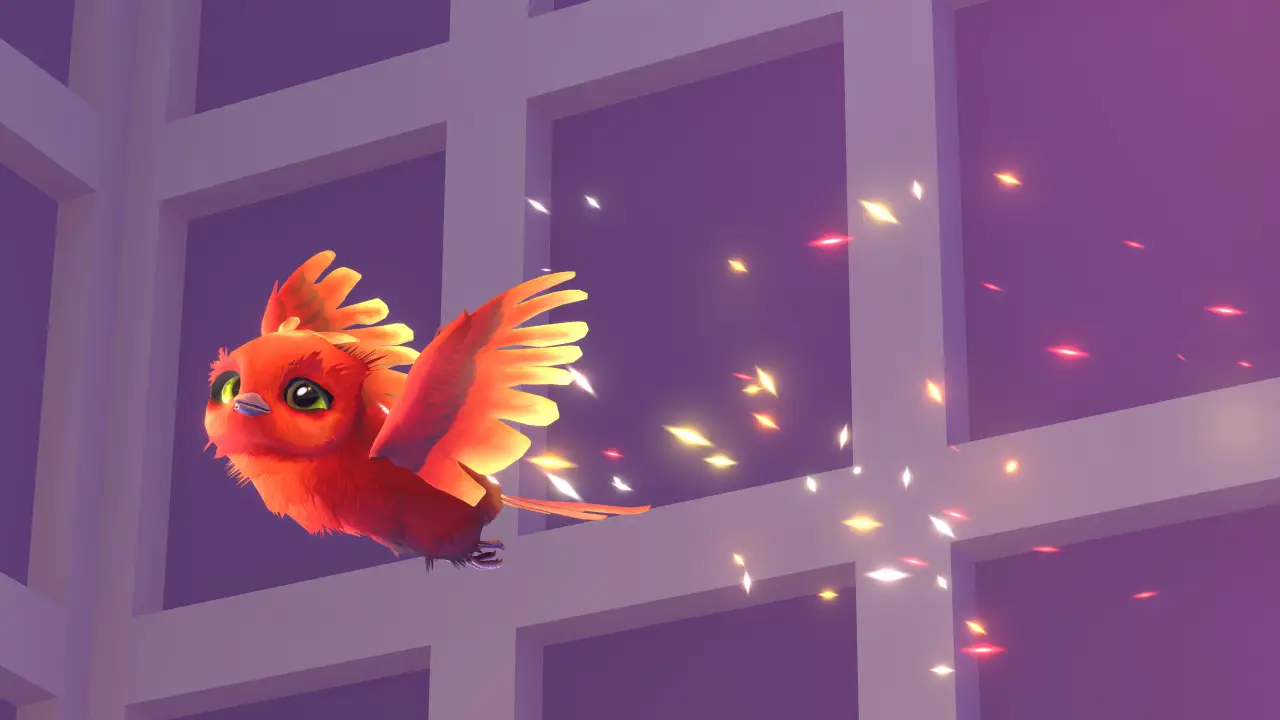

Leave a Reply
You must be logged in to post a comment.